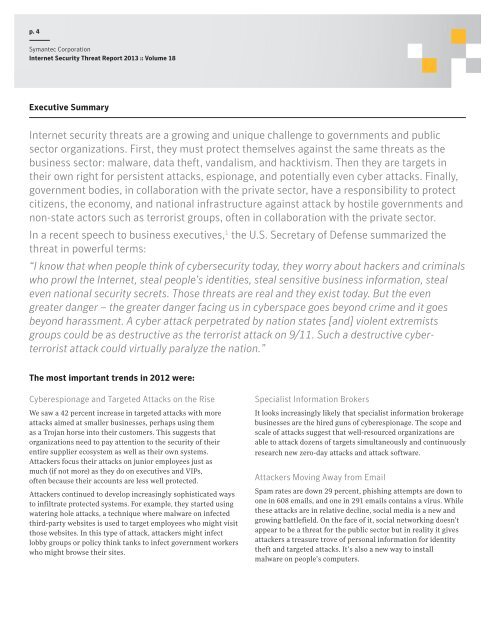internet security tHreAt rePOrt GOVernMent 2013
internet security tHreAt rePOrt GOVernMent 2013
internet security tHreAt rePOrt GOVernMent 2013
You also want an ePaper? Increase the reach of your titles
YUMPU automatically turns print PDFs into web optimized ePapers that Google loves.
p. 4<br />
Symantec Corporation<br />
Internet Security Threat Report <strong>2013</strong> :: Volume 18<br />
Executive Summary<br />
Internet <strong>security</strong> threats are a growing and unique challenge to governments and public<br />
sector organizations. First, they must protect themselves against the same threats as the<br />
business sector: malware, data theft, vandalism, and hacktivism. Then they are targets in<br />
their own right for persistent attacks, espionage, and potentially even cyber attacks. Finally,<br />
government bodies, in collaboration with the private sector, have a responsibility to protect<br />
citizens, the economy, and national infrastructure against attack by hostile governments and<br />
non-state actors such as terrorist groups, often in collaboration with the private sector.<br />
In a recent speech to business executives, 1 the U.S. Secretary of Defense summarized the<br />
threat in powerful terms:<br />
“I know that when people think of cyber<strong>security</strong> today, they worry about hackers and criminals<br />
who prowl the Internet, steal people’s identities, steal sensitive business information, steal<br />
even national <strong>security</strong> secrets. Those threats are real and they exist today. But the even<br />
greater danger – the greater danger facing us in cyberspace goes beyond crime and it goes<br />
beyond harassment. A cyber attack perpetrated by nation states [and] violent extremists<br />
groups could be as destructive as the terrorist attack on 9/11. Such a destructive cyberterrorist<br />
attack could virtually paralyze the nation.”<br />
The most important trends in 2012 were:<br />
Cyberespionage and Targeted Attacks on the Rise<br />
We saw a 42 percent increase in targeted attacks with more<br />
attacks aimed at smaller businesses, perhaps using them<br />
as a Trojan horse into their customers. This suggests that<br />
organizations need to pay attention to the <strong>security</strong> of their<br />
entire supplier ecosystem as well as their own systems.<br />
Attackers focus their attacks on junior employees just as<br />
much (if not more) as they do on executives and VIPs,<br />
often because their accounts are less well protected.<br />
Attackers continued to develop increasingly sophisticated ways<br />
to infiltrate protected systems. For example, they started using<br />
watering hole attacks, a technique where malware on infected<br />
third-party websites is used to target employees who might visit<br />
those websites. In this type of attack, attackers might infect<br />
lobby groups or policy think tanks to infect government workers<br />
who might browse their sites.<br />
Specialist Information Brokers<br />
It looks increasingly likely that specialist information brokerage<br />
businesses are the hired guns of cyberespionage. The scope and<br />
scale of attacks suggest that well-resourced organizations are<br />
able to attack dozens of targets simultaneously and continuously<br />
research new zero-day attacks and attack software.<br />
Attackers Moving Away from Email<br />
Spam rates are down 29 percent, phishing attempts are down to<br />
one in 608 emails, and one in 291 emails contains a virus. While<br />
these attacks are in relative decline, social media is a new and<br />
growing battlefield. On the face of it, social networking doesn’t<br />
appear to be a threat for the public sector but in reality it gives<br />
attackers a treasure trove of personal information for identity<br />
theft and targeted attacks. It’s also a new way to install<br />
malware on people’s computers.


